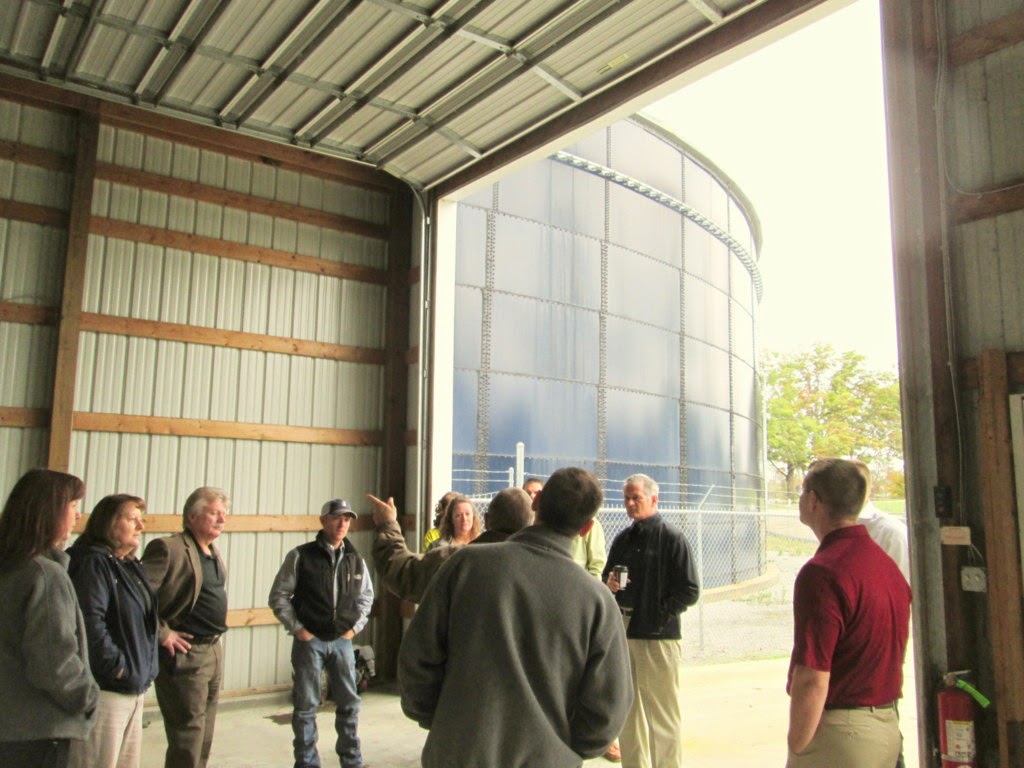So while we were in Nashville, we went up the road to pay a visit to one of AgroLiquid's top Area Managers: Security Seed and Chemical. They have a number of locations throughout Tennessee, Kentucky and Indiana. But their main office is a short drive to Clarksville, TN. They also have a barge terminal in Clarksville on the Cumberland River. Here they take in 32% UAN (a nitrogen fertilizer solution) off of a barge in the river and put it in that big 2.6 million gallon tank outside the truck loadout building below. Johnny Rudolf, one of the founders of Security Seed who was lured out of retirement to manage this facility, gives us the company tour.
This big tank is 3300 feet from the river, seen in the background next to the sign below. You may be wondering how in the world do they get that liquid N all the way up the hill into this tank. I know I was. Well they use air pressure to do the job. That must be some pump. Probably would be good for air mattresses too. Very impressive.
This facility is open 24 hours a day. Not that Johnny is here all that time to load a truck. Here's how it works. An order is placed into the system, and a tanker driver can come in any time and fill up. He enters the secret code to open the door, pulls in and goes up the stairs to that controller on the right in the picture. He opens up the tanker hatch and inserts the hose, enters in a special code for his specific order, and pushes "play", or something similar. It can load a tanker in ten to twelve minutes, and they have run upwards of 50 trucks a day during busy season. It has also been a great competitive tool for them.

For further security they have these scary bugs around. I saw this dead one on the pavement. It was huge, around 1.75 inches long. I should have put down a quarter for reference, but it was really big. I had never seen one before, so I Googled it as "big green beetle in Tennessee." It worked, and told me this is an Eastern Hercules Beetle. This one is a female since it lacks the "rhinoceros" horns of a male. Now that would make me not want to go barefooted around there.
Out back they have the ingredient that makes the 32% work even better. There are several 6500 gallon tanks for eNhance that is blended with the 32% UAN.
How is the eNhance added, you ask? Well they have these controllers that will add the correct amount to the 32% being loaded. It is all dictated by the order in the computer. Pretty cool. It should be mentioned that this river facility only handles nitrogen and eNhance. For other Liquid fertilizers you have to go somewhere else.
Next we drove over to Russelville, KY where they have plenty of Pro-Germinator, Sure-K and Micro 500. They have a rail spur that enables delivery in tankers to keep the tanks supplied for farmer demand there in Kentucky.
This facility is managed by Jamie Dezarn, there in the middle telling about the happenings here. You may have seen Jamie appear with me on an episode of "RFD-Live" a while ago. I told Jamie that I visited the new RFD-TV studios in Nashville, and maybe we could be on a future show together.
Well as Security Seed agronomist Lang French talked to the group, I don't think Jamie was listening. He was remembering his pre-show make up application from our show before.
Not that I haven't done the same thing.






























.JPG)




















